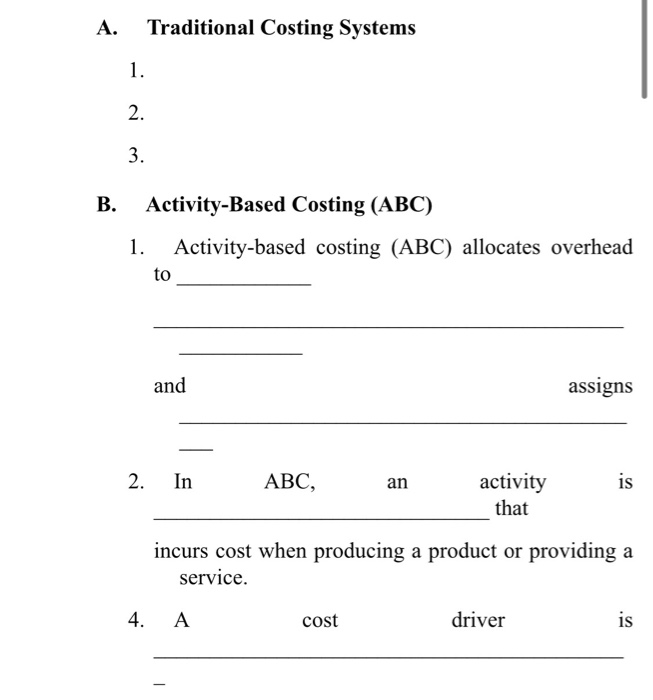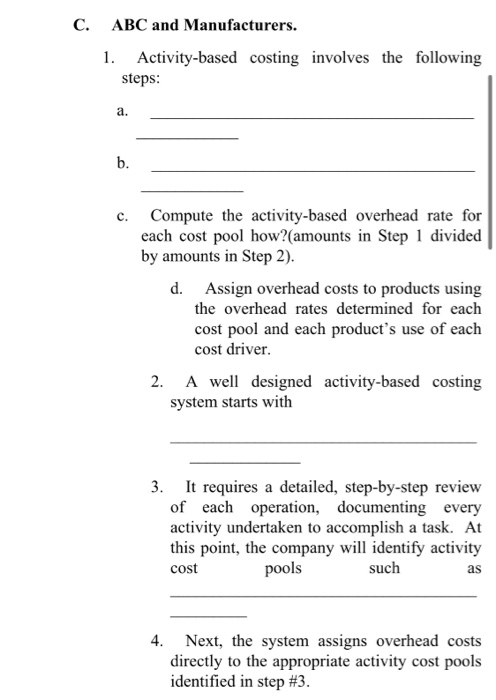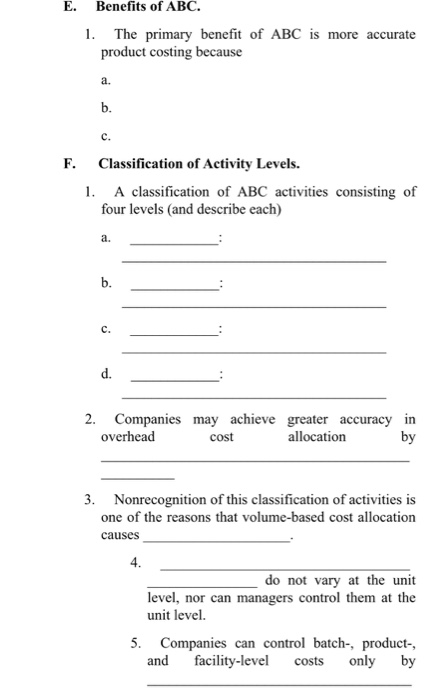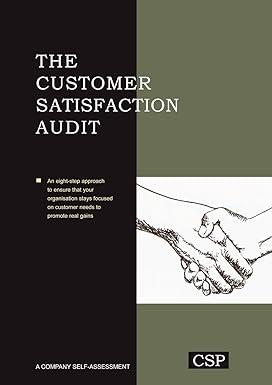A. Traditional Costing Systems 1. 2. 3. B. Activity-Based Costing (ABC) 1. Activity-based costing (ABC) allocates overhead to and assigns 2. In ABC, an is activity that incurs cost when producing a product or providing a service. 4. A cost driver is C. ABC and Manufacturers. 1. Activity-based costing involves the following steps: a. b. c. Compute the activity-based overhead rate for each cost pool how?(amounts in Step 1 divided by amounts in Step 2). d. Assign overhead costs to products using the overhead rates determined for each cost pool and each product's use of each cost driver. 2. A well designed activity-based costing system starts with 3. It requires a detailed, step-by-step review of each operation, documenting every activity undertaken to accomplish a task. At this point, the company will identify activity cost pools such as 4. Next, the system assigns overhead costs directly to the appropriate activity cost pools identified in step #3. D. Identify Cost Drivers, Compute Overhead Rates, and Assign Overhead Costs to Products. 1. After costs are allocated to the activity cost pools, company must the 2. A high degree of correlation must exist between the cost driver and the actual consumption of the overhead costs in the cost pool to achieve 3. The company computes an activity-based overhead rate per cost driver by 4. In allocating overhead costs, the company 5. The company multiplies by to be used per product to assign overhead costs to each product. 6. Under ABC, overhead costs are usually shifted from This shift results in more accurate costing because: Low-volume products often require a. b. Assigning overhead using ABC will usually and as compared to traditional overhead allocation. E. Benefits of ABC. 1. The primary benefit of ABC is more accurate product costing because a. b. c. F. Classification of Activity Levels. 1. A classification of ABC activities consisting of four levels and describe each) a. b. c. d. 2. Companies may achieve greater accuracy in overhead cost allocation by 3. Nonrecognition of this classification of activities is one of the reasons that volume-based cost allocation causes 4. do not vary at the unit level, nor can managers control them at the unit level. 5. Companies can control batch-, product-, and facility-level only by costs A. Traditional Costing Systems 1. 2. 3. B. Activity-Based Costing (ABC) 1. Activity-based costing (ABC) allocates overhead to and assigns 2. In ABC, an is activity that incurs cost when producing a product or providing a service. 4. A cost driver is C. ABC and Manufacturers. 1. Activity-based costing involves the following steps: a. b. c. Compute the activity-based overhead rate for each cost pool how?(amounts in Step 1 divided by amounts in Step 2). d. Assign overhead costs to products using the overhead rates determined for each cost pool and each product's use of each cost driver. 2. A well designed activity-based costing system starts with 3. It requires a detailed, step-by-step review of each operation, documenting every activity undertaken to accomplish a task. At this point, the company will identify activity cost pools such as 4. Next, the system assigns overhead costs directly to the appropriate activity cost pools identified in step #3. D. Identify Cost Drivers, Compute Overhead Rates, and Assign Overhead Costs to Products. 1. After costs are allocated to the activity cost pools, company must the 2. A high degree of correlation must exist between the cost driver and the actual consumption of the overhead costs in the cost pool to achieve 3. The company computes an activity-based overhead rate per cost driver by 4. In allocating overhead costs, the company 5. The company multiplies by to be used per product to assign overhead costs to each product. 6. Under ABC, overhead costs are usually shifted from This shift results in more accurate costing because: Low-volume products often require a. b. Assigning overhead using ABC will usually and as compared to traditional overhead allocation. E. Benefits of ABC. 1. The primary benefit of ABC is more accurate product costing because a. b. c. F. Classification of Activity Levels. 1. A classification of ABC activities consisting of four levels and describe each) a. b. c. d. 2. Companies may achieve greater accuracy in overhead cost allocation by 3. Nonrecognition of this classification of activities is one of the reasons that volume-based cost allocation causes 4. do not vary at the unit level, nor can managers control them at the unit level. 5. Companies can control batch-, product-, and facility-level only by costs










